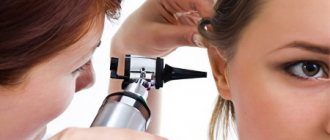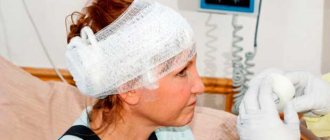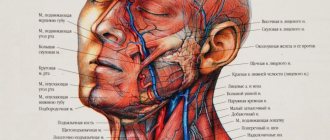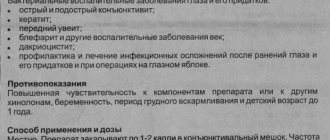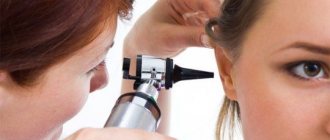ARVI unsettles both adults and children. One of the symptoms of a cold is headache. A draft, a walk in inclement weather, or hypothermia are enough to make you feel unwell.
The risk of the disease increases in the autumn-winter period. A disease that is viral or infectious in nature affects a person’s quality of life, because a cold causes not only sneezing and coughing, but also an increase in body temperature and weakness.
A reasonable decision at the first symptoms of a flu infection would be to consult a specialist. An experienced doctor will tell you what methods will help get rid of headaches, alleviate the patient’s condition and prevent complications.
But severe headaches with a cold come in different forms. To correctly prescribe treatment, you should listen carefully to the body, catch warning signals in time and prevent the development of pathology.
The first symptoms of the disease should alert you: sore throat, slight chills, discomfort in the nasopharynx, difficulty breathing, lethargy, aching sensations in the joints of the arms and legs. Such manifestations are characteristic of a viral infection.
At different stages of the disease, they are accompanied by a headache due to ARVI, which is an integral companion of inflammatory processes in the sinuses and is accompanied by an increase in temperature.
The patient may experience, among other painful sensations:
- pressing headache, which is bursting in nature,
- stabbing, painful pulsation in certain areas of the head,
- aching, disturbing pain throughout the day, reaching high intensity in the evening,
- dull constant painful sensations, acute episodic or wave-like,
- affecting the area of the eye closer to the bridge of the nose, with lacrimation, photophobia, a pronounced reaction to sunlight,
- discomfort when turning the head sharply, pain is especially intensified when bending over, blowing your nose, sneezing, coughing.
The localization of pain during a cold is most often observed in the occipital or frontal area, and with a fever accompanied by profuse sweating - in the temporo-parietal region, radiating to the ears and eyes. In the morning hours, pain symptoms appear due to blocked sinuses.
Flu symptoms
Headache accompanies any viral disease, as it provokes inflammation of the mucous membranes and activity of the immune system. The flu is a lot like a cold. The only thing that distinguishes it is the rapid rise in temperature. If a cough is combined with a fever, it is 100% of cases the flu. It is often complicated by bronchitis and sinusitis. A headache with ARVI increases as leukocytes become active against the virus, and with influenza it often appears as a sign of intoxication and dehydration.
Influenza headaches have typical characteristics:
- squeezing and expansion of the head;
- sensitivity to light and tearing;
- monotonous pain appears regardless of the time of day or activity.
The appearance of a sign indicates that the lymphatic and circulatory systems are involved in the fight against infection.
The exception is pain caused by a bacterial infection. Sinusitis causes pain in the bridge of the nose that increases in the evening, sinusitis makes it impossible to bend forward and turn the head, otitis is severe pain in the ear, radiating to the jaw.
There are signs of dangerous flu headaches that:
- do not go away after painkillers;
- growing every day;
- are saved regardless of the day of the day;
- accompanied by nausea and vomiting;
- associated with muscle spasm in the back of the neck.
In rare cases, the influenza virus can penetrate the meninges and cause inflammation. Most often, headaches are caused by overstrain of the neck muscles.
Why do you have a headache when you have ARVI?
Penetration of a respiratory virus into the body leads to the destruction of cells of the mucous membrane of the nasopharynx. If treatment is not started, the disease moves down the trachea to the bronchi, and in the most unfavorable course it invades the lungs.
If the intoxication is significant, then a headache appears. The risk zone is a cold with ARVI superimposed on it. Initially, the pain is localized in the frontal, temporal part, near the superciliary arches.
The temperature may not exceed 37-37.3 degrees, but its increase is accompanied by an increase in the area of pain, the appearance of heaviness, and pulsation.
Experts identify several main causes of painful manifestations in the head area during ARVI:
- Boring cough at a late stage of the disease.
- The development of the most severe respiratory form - influenza.
- The appearance of purulent sinusitis due to an associated bacterial infection.
- Specification of sinusitis – sinusitis, frontal sinusitis, sphenoiditis.
- A complication represented by inflammation of the trigeminal nerve.
- Addition of meningitis.
- Exacerbation of migraine.
The table shows the dependence of the nature of headaches against the background of ARVI on their causes.
| Cause of pain | Features, localization of pain |
| Coughing | Heaviness occurs in the upper part of the head, temples |
| Flu | Brow ridges, eye sockets |
| Sinusitis | Maxillofacial pain of a dull, pulsating, bursting nature |
| Acute sinusitis | Maxillary (maxillary) sinuses, projection to the temple, cheekbones, forehead - acute course, manifests itself in the evenings |
| Frontit | Bursting, pressing, dull pain in the frontal region, especially after bending the head; in acute cases - in the mornings, in chronic cases - in the evenings |
| Sphenoiditis | Temples, crown, back of head, eye orbits |
| Trigeminal neuralgia | Maxillofacial, temporal regions |
| Meningitis | Strong or weak constant, growing - “spread” throughout the head |
| Migraine | Strong unilateral, sensitive to irritants |
The table gives a general idea of the signs of various diseases depending on the type of pain in the head, but the final word remains with the doctor.
↑
https://gidpain.ru/bolit/golovnaya-orvi.html
Causes of headaches with influenza
Symptoms associated with influenza often occur simultaneously with an increase in temperature. Influenza viruses cannot reproduce in a high-temperature environment, so the body creates conditions for its disinfection - fever. The natural reaction is the filling and expansion of blood vessels, including those in the skull. This leads to an increase in pressure inside the head, creating a feeling of pulsation, heaviness, fullness and sometimes pain.
Helpful information
A similar headache with influenza is aggravated by sinusitis. The mucous membranes of the air sinuses and nasal cavity become inflamed and swollen. This also increases pressure on the soft tissues in the face and eyes, and the headache increases.
There is another physiological mechanism for the appearance of headaches during ARVI. Flu symptoms begin with viruses entering the tissues of the nose and throat. The body reacts to them by producing protective mucus due to inflammation. When an infection damages healthy cells, the surrounding sympathetic nerves in the body are activated. They are the ones who send signals of pain.
However, the impulse reaches not only the brain, but also the neck and upper back. The tissues of the pharynx are attached to the occipital bone from the inside and come into contact with the membranes of the cervical spine. Therefore, against the background of the flu, spasm in the cervical spine, pain and deterioration of mobility occur. Activation of the sympathetic nerves also causes the mucous membranes of the throat and nose to produce thick mucus, which causes a runny nose and cough with phlegm.
Tight muscles of the neck and shoulder area, mucous secretions and irritated areas of the spine, which receive impulses from the tissues, cause the accumulation of blood and lymphatic fluids. It is the stagnation in the throat, neck, and then head that causes pain bursting from the inside.
"Nurofen"
What to take for a headache with a cold? A non-steroidal anti-inflammatory drug will help quickly relieve the unpleasant symptom. The active ingredient of the drug is ibuprofen. Additionally, the tablets contain substances such as croscarmellose sodium, stearic acid, silicon dioxide. The indication for taking the medicine is fever due to ARVI, pain of any etiology. The drug has many contraindications. These are erosive and ulcerative diseases of the gastrointestinal tract, bronchial asthma, renal and liver failure. Do not use Nurofen if there is hypersensitivity to any component of the drug.
It is important to strictly follow the dosage of the drug indicated in the instructions. Adults are recommended to take 1 tablet three times a day. The medication is not intended for long-term use. You will have to pay about 100 rubles for a package of Nurofen tablets.
How to relieve a headache with the flu?
The pain relieves spontaneously when the temperature drops and the signs of sinusitis subside. But you can relieve discomfort by ventilating the room, drinking plenty of fluids and resting. The flu cannot be carried on your feet.
Medications
The most popular drugs for headaches with influenza are acetaminophen (another name for Panadol) and ibuprofen - they simultaneously block two cyclooxygenase enzymes and suppress inflammation in the central nervous system in the centers of pain and temperature. Therefore, after taking it, body aches and fever decrease, and even the production of nasal mucus decreases. Long-term use of acetaminophen and ibuprofen is undesirable due to the negative effect on the liver.
Another remedy that can be used for low body temperature is citramon. Complex remedies against flu symptoms include acetylsalicylic acid.
American studies have proven that some antiviral drugs can cause headaches. The mechanism of this connection is intoxication, as well as the proximity of the liver to the diaphragm - the respiratory muscle. If the liver capsule is under tension due to increased work, the expansion of the ribs to which the organ is attached is difficult. When you inhale, the neck muscles begin to overload, which causes pain.
Non-drug methods
The most effective way to overcome flu headaches is to support your immune system with home remedies. The most common methods include echinacea tincture. It has been proven that cherry juice and viburnum, ground with sugar, improve immunity well. Raspberries, in addition to anti-inflammatory components, contain antipyretic substances.
For headaches, any remedy that clears the nasal passages helps. A warm cloth placed on the face in the sinus area helps relieve inflammation, swelling and facilitate the passage of mucus. Inhaling water vapor with menthol or peppermint helps clear the nasal passages. The steam should not be too hot.
Cold cloth compresses on the forehead or temples reduce dilation of blood vessels, relieving pressure and pain. In the room where the patient is, you need to dim the lights and turn off the TV to avoid loud sounds. It is better to keep your head elevated.
Helpful information
At home, acupuncture points can help relieve sinusitis headaches by massaging them for one minute several times a day.
There are four sinuses in the bones of the skull, each of which can become inflamed and blocked during the flu. They represent a single system of cavities between the forehead, eyes (frontal and ethmoid bones), sphenoid bone, and maxillary sinuses. The cavities are lined with a thin, soft mucous membrane, and are normally empty. Inhaled air passes through them to humidify, sometimes bacteria and viruses are retained on the walls. Massage for sinus drainage is performed at home:
- Use your fingertips to easily massage the skin, starting from the midline of the forehead towards the temple, down past the ear to the neck. Finish the technique by stroking the neck down to the collarbone forward and to the shoulder blade back. Perform on both sides of the face, repeat three to four times.
- Do a similar massage, but starting from the bridge of the nose. Stroke towards the cheekbones and ears, then massage down to the neck and collarbones. Repeat on both sides 3-4 times.
- Using your fingertips, lightly press on the forehead area, imitating playing the piano. You can do light tapping. Repeat the technique on the bridge of the nose, wings of the nose, above and below the cheekbones. Then perform the two strokes described above once.
- Then gently massage the area around the eyes, starting from the inner corner. Press the point located at the intersection of the eyebrows and eyes. Once again, perform two stroking techniques with your fingertips.
In Chinese medicine, there is a point that relieves even severe migraines, which have worsened against the background of a viral infection. It is located in the muscle layer between the thumb and index finger. The point of energy balance is most often painful, which indicates a stressful state. But the flu is a kind of stress for the body, and a headache is a signal that the body needs time to adapt.
At home, you can improve your own condition by doing a series of stretches for headaches. Its purpose is to relax the muscles of the neck, the spasm of which blocks the lymphatic drainage from the head:
- Lying on your back, place two fists under the back of your head so that the pressure is above the suboccipital muscles for one minute. You can use tennis balls wrapped in a sock.
- Place one hand on the protrusion on the bone behind the ear, the other on the back of the head. Make a stretching motion for a minute, as if trying to stretch the seam between the bones. Repeat for the second side.
- Place your palm on the back of your head, and with the finger of your other hand slowly walk along the center of your forehead down to the bridge of your nose. Gently pressing on the skin millimeter by millimeter.
- Lying on your back, turn your head to the right side and feel the protruding muscle on the left side of your neck. Gently massage it from top to bottom. If you identify a painful point, press it with your finger and hold for a minute. Turn your head to the left side, repeat the technique on the right.
- Sit on a chair, place your hand of the same name on your left collarbone. Tilt your head to the right and slightly back. When you feel tension, hold and relax. Wait until the stiffness decreases. Repeat for the other side.
The massage is aimed at relaxing the muscle membranes that are attached to the bones of the skull. He helps:
- stimulate blood circulation, increasing the immune response;
- improve venous and lymphatic drainage, reduce swelling;
- facilitates joint movement and irritation of the sympathetic nerve, therefore reducing mucus production.
Reducing muscle spasm generally improves well-being and pain in the body.
The body is designed to resist viruses with the help of the immune system. A key component of this mechanism is the lymphatic system. With the help of gentle stretching and massage, you can relieve muscle spasms and reduce pain. Lymphatic drainage will allow immune cells to penetrate into tissues and overcome the virus. But there is another important component of fighting the flu - drinking plenty of fluids.
Pain and fever are signs that you need to drink more fluids. When the temperature rises, interferons and cytokines actively circulate in the blood and need movement. If the urine becomes darker and the number of urinations per day decreases, you need to control your water consumption. Required to drink a cup of water or other liquid, excluding alcoholic and caffeinated drinks, per hour.
A sufficient amount of fluid reduces headaches and supports the immune system. This is how essential proteins move through fluids throughout the body. Dehydration interferes with their movement.
Headache after flu
The cause of a headache after an infection may be normal exhaustion of the body. When the main symptoms pass, patients notice sleep disturbances, drowsiness, and weakness for another 1-3 weeks. This condition is called asthenic syndrome, which is sometimes accompanied by headaches.
Causes
Dangerous causes of persistent headache after the flu are complications. When an infection penetrates through the bloodstream into the central nervous system, it affects the membranes of the spinal cord and brain.
Arachnoiditis is an inflammation of the arachnoid membrane with the identification of adhesions and cystic formations. Complications include dizziness, nausea, memory and sleep disturbances, and sweating. Headaches appear after physical activity. Their increase indicates the development of an inflammatory process; treatment is carried out only in a hospital.
The peculiarity of arachnoiditis is that symptoms appear long after the initial infection, so no one perceives it as a complication of the flu. Headache occurs in the cerebral form of the disease, as a manifestation of intracranial hypertension. Diagnosis is based on the jumping symptom; after jumping, the pain increases sharply.
Meningitis is an inflammation of the soft membranes of the brain, which has a striking distinctive sign - severe spasm of the neck muscles. Due to tension, the patient cannot press his chin to his chest, tilting his head. Photophobia develops, headaches increase, accompanied by vomiting and confusion. The emergency condition requires hospitalization.
Post-infectious asthenia is a condition that indicates severe exhaustion of the body even before the onset of infection. The flu, transmitted on the legs, always has a long “tail” with a headache.
How to treat?
Treatment of these complications depends on the pathogen that led to inflammation. For bacterial infections, these are antibiotics and antihistamines. For viral infections – antiviral agents, corticosteroids, neuroprotective and vascular agents. When the volume of cerebrospinal fluid increases, dehydration agents are used. When seizures occur, anticonvulsants are used. The body is supported with vitamins and antioxidants. The combined action drug Actovegin is used, which improves metabolic processes in brain tissue.
With post-infectious asthenia, the body needs to be supported with B vitamins, vitamin C, and zinc. Prescribed drugs with succinic acid, which helps produce energy in cells. Headaches are treated with conventional painkillers.
After infections accompanied by intoxication, the cranial aponeurosis, the connective tissue that covers the head, remains under tension. The muscles of the cervical region - the collar zone - spasm. Stimulating acupuncture points with pressure relieves tension headaches. After the procedure you need to drink water.
Folk remedies
If you don’t want to “overload” your body with various medications, then you can turn to equally effective folk remedies. Help relieve headaches:
- menthol oil. Lubricate the back of the head, the area behind the ears, forehead and temples;
- lemon. You should wipe its peel and pulp, and lubricate the temples and forehead with the resulting gruel;
- lavender oil. You need to drop 3 drops of oil on a handkerchief and inhale the aroma for several minutes;
- rose, basil or marjoram oil. You need to massage your temples with it.
During colds, herbal teas and infusions will relieve headache attacks:
- Brew 0.5 tsp. elderberries. After 15 min. strain. Drink 0.5 glasses twice a day.
- Pour boiling water over 1 tbsp. l. mint. Keep the mixture in a water bath for 15 minutes, then wrap it up for 1 hour. Drink 0.5 glasses three times a day.
- Pour boiling water over 2 tsp. grass of the open lumbago. After a day, strain. Drink throughout the day.
- Pour boiling water over 1 tbsp. l. clover flowers. Wrap and leave for 40-60 minutes. Strain. Drink 0.5 cups three times a day.
A cold compress quickly relieves headaches. You need to take water into a bowl, drop a little lavender or mint oil into it, and then wet a napkin or small towel. After placing the compress on your forehead, you need to stay in silence for 20 minutes.
A light massage of your fingers also helps a lot: you need to massage each finger along its entire length until the pain subsides.
A good method that literally appeals to many is the following. You need to take a little cognac into your mouth and spit it out after a few minutes, without swallowing it under any circumstances. Alcohol will dilate the blood vessels in the brain, thereby relieving pain.
Flu prevention
Stress is one of the reasons why the adaptation of the nervous system fails, after which it ceases to fully manage the body’s resources. Any infection enters a weakened body more easily and leaves it more difficult. To prevent infectious diseases during colds, you need to avoid crowded places, do not touch your nose and eyes with dirty hands, wash your hands, and rinse your nose with salt water after going outside.
Prevention includes taking vitamin C, echinacea tincture, and rosehip decoction. Proper nutrition supports the immune system, along with physical activity and walks in the fresh air. Adequate sleep of 6-7 hours is important for the recovery of the body.

